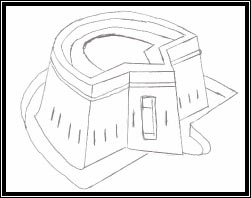

Coastal redoubts are the second category of coastal defences built in the early 18th century. The most numerous types of fortifications of this period were the coastal batteries, which were generally built in vulnerable bays opposite each other and armed with cannons. On the other hand coastal redoubts were built in the middle of the bay in order not to let enemy forces disembark their troops ashore. They operated as an infantry defensible stronghold to resist enemy troops. The idea of building this type of fortification was brilliant because if enemy soldiers were able to disembark their soldiers, they would overwhelm these fortifications quickly. The reason was because in the middle of the bay there was not fortification. But with the introduction of the coastal redoubt the situation was different because all the vulnerable points of the bay were defended by these coastal fortifications. 1
There were at least three different models of coastal redoubts. Those built in the village of Mellieha had a pentagonal platforms surrounded by low parapets and had a blockhouse at the rear of the structure. The majority of them were not armed with artillery and acted as defensive strongholds. The size too did not permit the use of artillery. The only coastal redoubt in Mellieha that was armed with artillery was the one built in the middle of Mellieha Bay which was armed with four 6-pdrs. Five out of eleven coastal redoubts were built in the village of Mellieha. This confirms the importance of the village in the Hospitallers’ military strategy. 3 There were two other types of coastal redoubts. The third category, which was not built in the Mellieha village, was similar to the French ones built in their colonies. This consisted of a structure similar to a tower and fitted with musketry loopholes in all the four walls. 3
|
||||||
|
|
||||||
References:
Researched and Written by: Charles Debono B.A.(Hons) History |
||||||
Maltaserv Bannerlink


